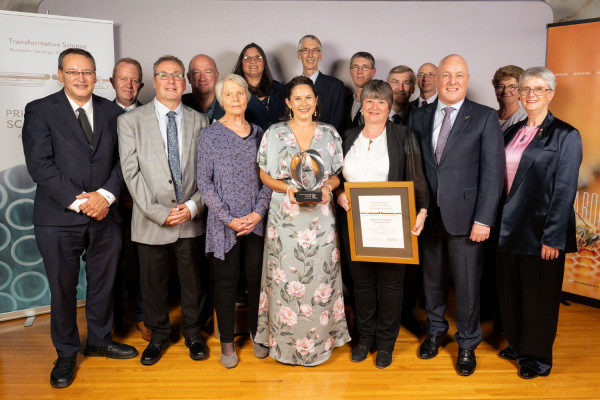It’s an extraordinary achievement for someone who began her scientific journey far from farm paddocks.
“I was born and raised a city girl and came to agriculture in a very roundabout way,” says Linda. “In fact, most of what I know about agriculture comes from what I’ve learnt here at AgResearch.”

Linda and AgResearch's Endophyte Discovery Team with Christopher Luxon after the Prime Minister awarded them with his Science Prize.
Originally from Whanganui, Linda’s early academic interests lay in chemistry and genetics. It wasn’t until a particularly inspiring university lecturer introduced her to DNA that her fascination with molecular biology truly took hold. She pursued biochemistry and genetics at Massey University, eventually completing a Master’s degree with Professor Rosie Bradshaw on fungal biology. It was a turning point: “I thought, ‘I quite like this, I’ll give it a go’.”
That ‘give it a go’ attitude led her far. A stint in Japan as a visiting scientist sharpened her lab skills and gave her the confidence to aim higher. She followed up with a PhD in fungal molecular biology at West Virginia University in the United States, where her focus on endophytes—microorganisms that live within plants and enhance their performance—began in earnest.
“When I started my PhD in 2000, endophytes were considered unremarkable because no one had identified genes involved in the symbiosis,” she explains. “But I found a few, and what’s really funny is that two of those genes are still being studied today—we still don’t fully understand them!”
Returning to New Zealand in 2003, Linda joined AgResearch and has spent the last two decades pushing the boundaries of endophyte science. Today, she leads teams at the forefront of plant-microbe interactions, helping to unlock the potential of these symbiotic organisms in sustainable agriculture.
Ryegrass and endophytes: partners in pasture
One of Linda’s key research focuses is the relationship between perennial ryegrass—New Zealand’s dominant pasture grass—and its fungal partner, Epichloë endophytes. These endophytes live within the plant’s above-ground tissue and produce natural chemicals that deter insect pests. In return, the endophyte gains a safe, nutrient-rich environment.
However, not all endophytes are created equal. “Farmers were facing animal health issues like ryegrass staggers, which made livestock behave as if they were drunk,” Linda says. “At first, the thinking was to remove endophytes altogether—but that left the pasture defenceless against insects.”
Instead, the AgResearch team took a more ambitious path: they searched globally for new, safer endophyte strains—ones that protect plants without harming livestock. This meant drawing on a diverse set of scientific disciplines, from microbiology and molecular biology to agronomy, chemistry and animal science.
Their work has led to the development of successful endophyte strains like AR37, now widely used in New Zealand pastures. More recently, they’ve achieved world-first breakthroughs by extending the Epichloë host range to cereal crops like rye and wheat, and pioneering the use of CRISPR gene-editing to customise endophytes for better pest resistance without animal toxicity.
Recognition and the road ahead
Winning the Prime Minister’s Science Prize is, in Linda’s words, “a recognition of decades of hard work.” Many in the Endophyte Discovery Team have dedicated their entire careers to this field, she says, and the prize also shines a welcome light on the value of agricultural science.
It’s not the team’s only accolade. In 2023, they also received the Primary Industries New Zealand Science & Research Award for their world-leading development and commercialisation of novel Epichloë strains.

Now, the team is looking to the future, including exploring how endophytes might support climate resilience by improving heat tolerance and nutrient uptake in pasture plants.
“There’s still so much to discover. And while I never imagined working in agriculture, I’ve found that science is science—what matters is curiosity, teamwork and the drive to solve real-world problems,” Linda reflects.
For a self-confessed city girl who didn’t plan to be a scientist, Dr Linda Johnson has certainly made herself at home in the heart of New Zealand’s rural science success.